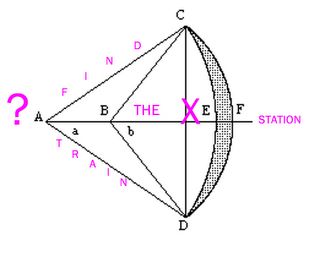
Sighting Gravity
Following is a description of the "gravity sextant", which is a
simple (though not very practical) device for determining the
exponent of a spherically symmetrical force law of the form
F = 1/r^c.
The sextant (or perhaps "quadrant" would be more correct) consists
of a right angled frame subtended by a protractor, similar to a
normal sextant. At the end of each arm of the right angled frame
is a mass held by a spring in a slider. Both of the sliders are
parallel to one of the arms, as illustrated below:
Oriented so that the plane of the sextant contains the center of the
field source, rotate the sextant until the displacements of the masses
in the two sliders are equal, and then sight the field source on a
line through the corner of the frame, and mark the angle on the
protractor.
The angle "theta" between the line of sight and the slider direction
is related to the exponent c in the force law according to the equation
tan^2(theta) + (c+1)tan(theta) - c = 0
For example, if the angle reads 29.3165 degrees, then we have c=2, so
we know the field obeys an inverse square force law. On the other
hand, if the angle reads 22.5 degrees, then c=1, and the field obeys
a simple inverse law. If the angle reads 32.8524 degrees, then the
field obeys an inverse cube law.

1 comment:
Dear Mr. Jesse-
I Am liking your science very much, and have been coming to like-minded art before and so we are sharing much already! I don't know if you have My Space page, but maybe you would like to come visit me and my Orchester there. I make sounds (not music) that has prevalent connection to science and art. Hoping on seeing you soon.
-Heinrich Mahler
Post a Comment